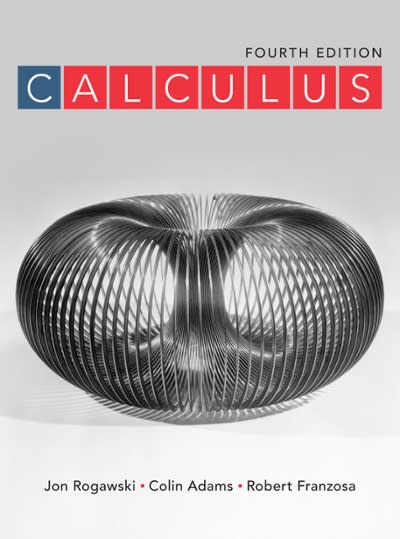Let (mathcal{S}) be the surface with parametrization [ Phi(u, v)=left(left(1+v cos frac{u}{2}ight) cos u,left(1+v cos frac{u}{2}ight) sin
Question:
Let \(\mathcal{S}\) be the surface with parametrization
\[
\Phi(u, v)=\left(\left(1+v \cos \frac{u}{2}ight) \cos u,\left(1+v \cos \frac{u}{2}ight) \sin u, v \sin \frac{u}{2}ight)
\]
for \(0 \leq u \leq 2 \pi,-\frac{1}{2} \leq v \leq \frac{1}{2}\)
CBS Use a computer algebra system.
(a) Plot \(\mathcal{S}\) and confirm visually that \(\mathcal{S}\) is a Möbius strip.
(b) The intersection of \(\mathcal{S}\) with the \(x y\)-plane is the unit circle \(\Phi(u, 0)=(\cos u, \sin u, 0)\). Verify that the normal vector along this circle is
\[
\mathbf{N}(u, 0)=\left\langle\cos u \sin \frac{u}{2}, \sin u \sin \frac{u}{2},-\cos \frac{u}{2}ightangle
\]
(c) As \(u\) varies from 0 to \(2 \pi\), the point \(\Phi(u, 0)\) moves once around the unit circle, beginning and ending at \(\Phi(0,0)=\Phi(2 \pi, 0)=(1,0,0)\). Verify that \(\mathbf{N}(u, 0)\) is a unit vector that varies continuously but that \(\mathbf{N}(2 \pi, 0)=\) \(-\mathbf{N}(0,0)\). This shows that \(\mathcal{S}\) is not orientable-that is, it is not possible to choose a nonzero normal vector at each point on \(\mathcal{S}\) in a continuously varying manner (if it were possible, the unit normal vector would return to itself rather than to its negative when carried around the circle).
Step by Step Answer:






